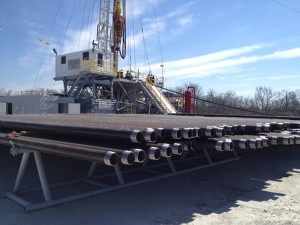Monday, March 17th, 2014 and is filed under Oil and Gas Current Events
 Booming energy production in the Permian Basin of Texas and New Mexico is driving one of the fastest growing regional economies in America. Midland and Odessa Texas—in the heart of the Permian Basin—are the two of the nation’s fastest growing economies. Permian oil production is surging so resoundingly that it is not only surpassing the Eagle Ford Shale formation in South-Central, Texas; it is eclipsing production in North Dakota’s Bakken formation as well.
Booming energy production in the Permian Basin of Texas and New Mexico is driving one of the fastest growing regional economies in America. Midland and Odessa Texas—in the heart of the Permian Basin—are the two of the nation’s fastest growing economies. Permian oil production is surging so resoundingly that it is not only surpassing the Eagle Ford Shale formation in South-Central, Texas; it is eclipsing production in North Dakota’s Bakken formation as well.
Permian crude oil production is expected to hit a record 1.41 million barrels a day in March, up from 1.3 million a year earlier according to the Energy Information Administration. In addition, the U.S. Oil rig count surged in early March to 1,443—the highest total since the industry began tracking the counts in 1987 (Texas marked 755 oil rigs, for a total of 864 oil and gas rigs).
The surge is primarily driven by the dynamism of the Permian Basin, which racked up a count of 504 oil rigs (506 total oil/gas). At the close of 2013, there were 460 rigs (452 oil, 8 gas) along the formation
The formation is so dynamic and rich in potential that Los Angeles-based Occidental Petroleum is spinning off its California operations and moving to Houston so that it can intensify its focus on its most profitable asset: the Permian. Occidental controls some 1.9 million acres in the area and is the formation’s largest producer.
Drillers have pulled some 29 billion barrels of oil out of this hydrocarbon laced ancient sea floor since it was first discovered in 1921. But over the last 90 years, production has wavered, sloping downward during the 1960s and 70s and recovering with higher oil prices in the late 70s and 80s, before declining again in the 1990s.
In recent years production has come roaring back. While traditional wells have been drilled in the area since its discovery, innovative technologies such as fracking and horizontal drilling are cutting costs and mitigating exploration risks. Producers are optimistic the region’s vast overlapping layers of petroleum-soaked shale rock will yield anywhere from 29-to-50 billion additional barrels.
Since May 2011, the formation has shown consistent month-on-month crude oil production growth. And companies operating in the area are poised to dramatically increase production. Analysts project Permian crude oil production will hit at least 1.8 million barrels per day by the end of 2016. That’s an increase of almost 60 percent from current levels. The consensus among oil industry experts is that the area’s production level will easily top 2 million barrels per day within the next five years.
The Permian Basin produces roughly 75 percent of the Lone Star State’s crude oil and up to 20 percent of its natural gas. It will continue to be one of the most dominant regions for energy production in Texas—and the United States.
Because of shale production technologies and formations like the Permian, the U.S. is poised to overtake Russia in 2014 to become the largest non-OPEC petroleum producer in the world. And that standing should last. America’s estimated recoverable energy resources are the largest of any nation on the planet, followed by Russia, Saudi Arabia, and China.
RELATED >> Staging the Next Boom: Shale 2.0
RELATED >> Fracking Boom Driving Massive Industrialization in Louisiana
RELATED >> Eagle Ford Shale Boom May Soon Cross Mexican Border
RELATED >> Oil boom means big money, big needs in south Texas
© Copyright 2024 Aresco, LP. All rights reserved. | Privacy Policy | Site by A3K Marketing. Admin Log in